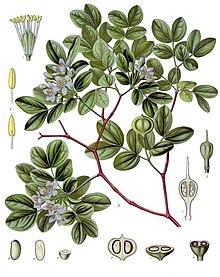| Zygophyllales | |
|---|---|

| |
| Guaiacum officinale | |
| Scientific classification | |
| Kingdom: | Plantae |
| Clade: | Tracheophytes |
| Clade: | Angiosperms |
| Clade: | Eudicots |
| Clade: | Rosids |
| Clade: | Fabids |
| Order: | Zygophyllales Link 1829 |
| Families | |
The Zygophyllales are an order of dicotyledonous plants, comprising the following two families:
- Family Zygophyllaceae
- Family Krameriaceae
According to the Angiosperm Phylogeny Group (APG II) both families are unplaced to order, but nevertheless included in the Eurosids I. The APG III system of 2009, however, recognized this order. Even if the monogeneric family Krameriaceae shares few common traits with the family Zygophyllaceae, researchers see little advantage in keeping it as a separate family (e.g. Sheahan and Chase). The name Zygophyllales can be used if one finds it appropriate to place both families into an order. The order remains unchanged in the APG IV system.
Under the Cronquist system, the Zygophyllaceae were included within the Sapindales, and the Krameriaceae within the Polygalales.
List of families
| Family and a common name | Type genus and etymology | Total genera; global distribution | Description and uses |
|---|---|---|---|
| Krameriaceae (ratany family) | Krameria, for Wilhelm Heinrich Kramer (1724–1765) | 1 genus, in southern North America and dry parts of South America | Parasitic shrubs and herbaceous perennials. Krameria triandra is used as an astringent in mouthwash and toothpaste. |
| Zygophyllaceae (twinleaf family) | Zygophyllum, from Greek for "yoked leaves" | 22 genera, scattered worldwide, mostly in dry tropical to temperate zones | Shrubs, trees and herbaceous plants, frequently with jointed branches, sometimes with thorns. Guaiacum yields exceptionally hard lumber. |
References
- Angiosperm Phylogeny Group (2003). "An update of the Angiosperm Phylogeny Group classification for the orders and families of flowering plants: APG II". Botanical Journal of the Linnean Society. 141 (4): 399–436. doi:10.1046/j.1095-8339.2003.t01-1-00158.x.
- Angiosperm Phylogeny Group (2009). "An update of the Angiosperm Phylogeny Group classification for the orders and families of flowering plants: APG III". Botanical Journal of the Linnean Society. 161 (2): 105–121. doi:10.1111/j.1095-8339.2009.00996.x. hdl:10654/18083.
- Angiosperm Phylogeny Group (2016). "An update of the Angiosperm Phylogeny Group classification for the orders and families of flowering plants: APG IV". Botanical Journal of the Linnean Society. 181 (1): 1–20. doi:10.1111/boj.12385.
- ^ Christenhusz, Maarten; Fay, Michael Francis; Chase, Mark Wayne (2017). Plants of the World: An Illustrated Encyclopedia of Vascular Plants. Chicago, Illinois: Kew Publishing and The University of Chicago Press. pp. 246–247. ISBN 978-0-226-52292-0.
- ^ POWO (2019). "Plants of the World Online". London: Royal Botanic Gardens, Kew. Krameriaceae, Zygophyllaceae. Retrieved January 1, 2023.
- IPNI (2022). "International Plant Names Index". London, Boston and Canberra: Royal Botanic Gardens, Kew; Harvard University Herbaria & Libraries; and the Australian National Botanic Gardens. Krameriaceae. Retrieved December 20, 2022.
| Orders of flowering plants (APG IV) | ||||||||||||||||||||||||||||||||||||||||||||||||||
|---|---|---|---|---|---|---|---|---|---|---|---|---|---|---|---|---|---|---|---|---|---|---|---|---|---|---|---|---|---|---|---|---|---|---|---|---|---|---|---|---|---|---|---|---|---|---|---|---|---|---|
| Angiosperms |
|  | ||||||||||||||||||||||||||||||||||||||||||||||||
This rosid article is a stub. You can help Misplaced Pages by expanding it. |